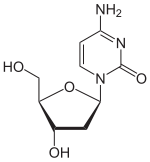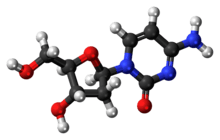Deoxycytidine
Deoxycytidine is a deoxyribonucleoside, a component of deoxyribonucleic acid. It is similar to the ribonucleoside cytidine, but with one hydroxyl group removed from the 2' position.
 | |
 | |
| Names | |
|---|---|
| Other names
2′-Deoxycytidine | |
| Identifiers | |
3D model (JSmol) |
|
| ChEBI | |
| ChEMBL | |
| ChemSpider | |
| ECHA InfoCard | 100.012.231 |
| MeSH | Deoxycytidine |
PubChem CID |
|
| UNII | |
CompTox Dashboard (EPA) |
|
| |
| |
| Properties | |
| C9H13N3O4 | |
| Molar mass | 227.217 |
Except where otherwise noted, data are given for materials in their standard state (at 25 °C [77 °F], 100 kPa). | |
| Infobox references | |
Can be phosphorylated at C-5 by Deoxycytidine kinase converting it to a thiamine nucleotide, a DNA precursor.[1]
It can also be used as a precursor for (5-aza-2′-Deoxycytidine) a treatment for MDS patients. This compound can slows the cell cycle by interfering with the methylation of the P15/INK4B gene, increasing the expression P15/INK4B protein. which subdues the transformation of MDS to leukemia.[2]
References
- Staub M, Eriksson S (2006). "The Role of Deoxycytidine Kinase in DNA Synthesis and Nucleoside Analog Activation". In Peters GJ (ed.). Deoxynucleoside Analogs In Cancer Therapy. Cancer Drug Discovery and Development. Humana Press. pp. 29–52. doi:10.1007/978-1-59745-148-2_2. ISBN 978-1-59745-148-2.
- Kim KW, Roh JK, Wee HJ, Kim C (2016). "Molecular Targeted Anticancer Drugs". In Kim KW, Roh JK, Wee HJ, Kim C (eds.). Cancer Drug Discovery: Science and History. Springer Netherlands. pp. 175–238. doi:10.1007/978-94-024-0844-7_9. ISBN 978-94-024-0844-7.
This article is issued from Wikipedia. The text is licensed under Creative Commons - Attribution - Sharealike. Additional terms may apply for the media files.